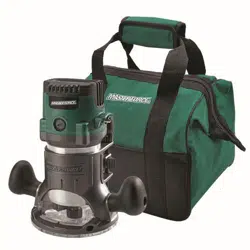Loading ...
Loading ...
Loading ...

Page 19
OPERATION
FIG. 19
GUIDE INSIDE
BIT
ROTATION
BIT
ROTATION
ROUTER FEED DIRECTION
GUIDE
THRUST
If there is a choice, the set-up in FIG. 19
is easier to use, but there is the possibility
of “Climb Cutting” around curves. In either
case, Fig. 18 or Fig. 19, the sideways thrust
of the router cutting is always against the
guide, as is proper.
WARNING:
Always securely clamp
the workpiece in place, and keep a rm
grip on the router base with both hands at
all times. Failure to do so could result in
loss of control causing possible serious
personal injury.
RATE OF FEED (FIG. 20-21)
The proper rate of feed depends on several
factors: the hardness and moisture content
of the workpiece, the depth of cut, and the
cutting diameter of the bit.
When cutting shallow grooves in soft woods,
such as pine, you may use a faster rate of
feed. When making deep cuts in hardwoods,
such as oak, you should use a slower rate
of feed.
FEEDING TOO RAPIDLY (FIG. 20)
FIG. 20
Bit shank
TOO FAST
Cut
Cutter
Clean and smooth finished cuts can only
be achieved when the cutting bit is rotating
at a relatively high speed, taking very small
bites, and producing tiny, clean-cut chips.
Forcing the feed of the cutting bit forward
too rapidly slows the revolution of the
cutting bit, and the bit takes larger bites as it
rotates. Larger bites mean larger chips and
a rough finish. This forcing action can also
cause the router motor to overheat.
Under extreme force-feeding conditions,
the revolutions can become so slow and
the bites become so large that chips are
only partially cut off, causing splintering and
gouging of the workpiece.
The router will make clean, smooth cuts if it
is allowed to run freely without the overload
of forced feeding. You can detect forced
feeding by the sound of the motor. Its usual
high-pitched whine will sound lower and
stronger as it loses speed. Holding the
router against the workpiece will also be
more difficult to do.
Loading ...
Loading ...
Loading ...
